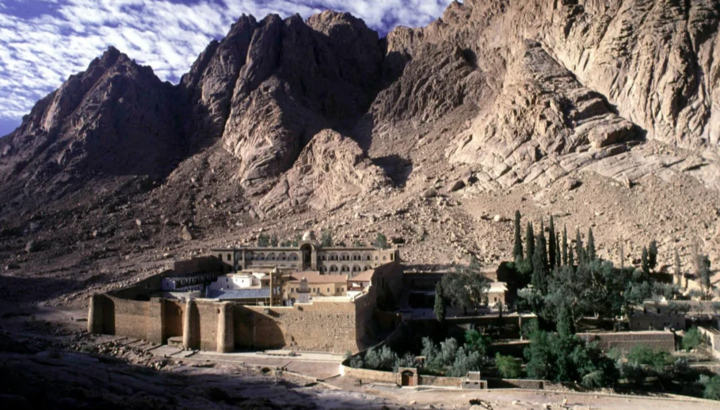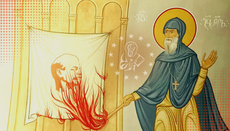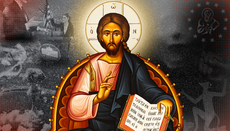Why Is St. Catherine's Monastery Orthodox, Not Coptic?

Why is St. Catherine's Monastery on Mount Sinai part of the Orthodox Church—not the Coptic Orthodox Church? This is a question few can answer... or even think to ask.
Down in the craggy shadow of Mount Sinai, where Moses once stood awestruck before the Burning Bush, sits St. Catherine’s Monastery, the oldest surviving Christian monastery. Thanks to St. Catherine’s, the deserts of Egypt are still wrapped in the cowl of prayer, as it was at the time of St. Moses the Black, St. John the Dwarf, and St. Anthony the Great.
Just this May, however, an Egyptian appeals court in Ismailia ruled St. Catherine’s and its surrounding lands, the court declared, belong to the state; the monks only have “usage rights.” The ruling, tied to a legal dust-up from 2012, sparked fears that Egypt’s “Great Transfiguration Project”—a government scheme to turn Sinai into a tourist trap—might not find room for the monks of St. Catherine. Archbishop Ieronymos II of Athens didn’t mince words, calling it a “historical fall” for Orthodoxy, as well as a gut-punch to religious freedom.
Greece’s government has offered diplomatic protection to the monastery, leaning on promises from the Prophet Mohammed (more on that in a moment) and, more recently, President Abdel Fattah El-Sisi. Egypt responded with a hasty claim that the ruling was “misinterpreted.” They had meant to enshrine the site’s sanctity, not threaten it. Yet the monks, unconvinced, closed their gates in protest.
Last week, the President of Greece received the Abbot of St. Catherine’s at the Presidential Palace in Athens. This suggests that Greece’s remains committed to protecting the Monastery, which is good. It also suggests that the threat from the Egyptian government is not abating, which is not so good.
St. Catherine’s Monastery—formally the Sacred Autonomous Royal Monastery of Saint Catherine of the Holy and God-Trodden Mount Sinai—was built between 548 and 565 AD by Holy Emperor Justinian I. It is a holy site for Christians, Jews, and Muslims alike, given its connection to the life of Moses.
Later, it became the resting place of Saint Catherine of Alexandria’s relics, found miraculously on a nearby peak, turning the monastery into a magnet for pilgrims. It has given the Orthodox Church innumerable saints, the best-known being Saint John Climacus, author of the Ladder of Divine Ascent.
Around the year 623, Muhammad—the founder of Islam—is said to have granted a charter of protection, known as the Ashtiname or “Covenant,” to the monks of St. Catherine’s. This document ensured the monks' safety, religious freedom, and exemption from taxes and military service, while calling on Muslims to protect the monastery. The monks claim Muhammad visited the monastery and had positive relations with them; the document is said to bear the imprint of his hand. Certified copies of this charter are preserved at the monastery, as the original was taken by Ottoman Sultan Selim I in 1517 to Constantinople for safekeeping.
Today, the Monastery and its surrounding community form an autocephalous church within the Orthodox communion: the Church of Sinai. Its primate is the abbot of St. Catherine’s, who rules under the title Archbishop of Mount Sinai and Raithu. He is elected by an assembly of the monks and consecrated by the Patriarch of Jerusalem.
The library at St. Catherine’s Monastery library, the oldest still in use, is a treasure trove—think the Codex Sinaiticus, a 4th-century Bible, and icons like the Christ Pantocrator, staring out from the 6th century. UNESCO declared it a World Heritage Site in 2002, and for good reason: this place has weathered Arab conquests, Crusades, Ottoman rule, and even a 2017 Islamic State attack. It is a fortress of faith.
But why does St. Catherine’s belong to the Orthodox Church and not the Coptic Church, given its location in the heart of sacred Egypt? That’s a question few can answer—or even think to ask.
St. Catherine’s unique situation has to do with the fact that it was built, not by native Copts, but by the Roman (Byzantine) Empire. Moreover, it was built almost a century after the Miaphysite schism that followed the Council of Chalcedon, and which eventually led to the Coptic people separating from the Orthodox Church.
Historically, St. Catherine’s attracted Arabs, Syrians, Georgians, and Greeks as well as Copts and Bedouins. This diverse makeup helped to ensure that the monastery never went over to the Coptic schism.
Under the Ottomans, St. Catherine's came to be dominated by ethnic Greeks. Today, the Hellenic Republic is a major patron of the Monastery, donating both financial but also political resources.
Today, Copts make up only about 10% of Egypt’s population. They have their own monasteries and a vibrant tradition under the Patriarch of Alexandria. But, again, St. Catherine’s was never theirs. It has enjoyed unbroken communion with the Orthodox Church since the Age of the Byzantines.
By God’s grace, the monks of St. Catherine Monastery will remain safe in their home—there, in the heart of the desert—and continue to sustain the Orthodox Church by their prayers for many years to come.









